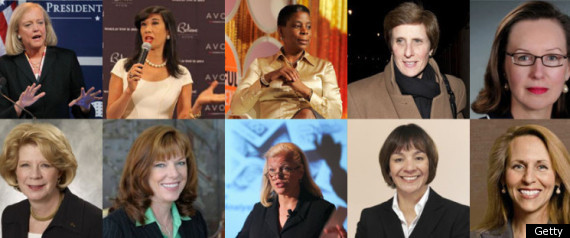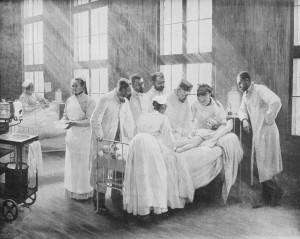Throughout history women
have usually been seen as lower than

men. When women grow up they are expected
to have children, raise them and take care of a household chores. This way of
viewing women is common in many countries and since many people feel that there
is nothing wrong with these views, they continue. About a hundred years ago, only
a few women in society were recognizable and most were not acknowledged at all
whatever their contribution may have been. Times are slowly changing and as our
society continues to grow and gain a more liberal mindset, the roles of women
begin to change. There’s a difference from the 21st century and the
previous ones, which is that this generation feels strongly about gender
equality. Women now don’t want to be known for their role of being homemakers,
they are now joining men in the work field. Some of these women are also
mothers who are able to juggle and multi-task their work and household duties.
They are having more privileges than before. Women are now able to go to school
to get a proper education, they can vote, they are free to give out their
opinions and suggestions without the authority of men questioning them and they
can be found working in almost all jobs where men mostly worked at and in
places where women weren’t usually accepted in.
Work Life
While
women have beat the label of "housewife" in the 20th century, there
are still tensions held between men and women in the workplace. Josette S.
Shiner, an editor of the "Washington Times," stated in a public
address that because women feel that they have to compete with men in the
workforce they start also behaving like them. Still other women, Shiner said,
gave up having a family altogether so they could focus more on work. In religious
institutions, the men are still cast as the leaders, only they can hold clergy
positions in some faiths. It has been reported that in 2014
for the first time in history, women are close to making it to a majority of
the national workforce. The economic downturn has hit men harder. During what
is now being called the "mancession", women were more able to retain
their jobs as opposed to men. The New York Times recently reported
that some of the highly educated, high powered women who "opted out"
of corporations starting in the 90s to raise children and take care of ailing
elders have now returned to the work.
Future
Soon we may have a female president and powerful woman are beginning
to dominate our society. Although women have a hard time getting
out of the role that the 20th century gave them, they keep trying to
change their roles and reach to higher expectations. As a society, we need to
continue to encourage people to go beyond stereotypes and recognize the
contributions that each individual, male or female, can make to the workplace. Also we need to see
that there shouldn’t be roles put on women because they can achieve much more
then what their role limits them too.
Rampell, Catherine. "The Mancession." Economix The Mancession Comments.
N.p., 10 Aug. 2009. Web. 29 May 2014.
The right to work and gain economic independence was one of the major battles for feminists in the 20th century. The feminist movement in the United States and abroad was a social and political movement that wanted to establish equality for women. The movement transformed the lives of many individual women and had a profound effect upon American society throughout the twentieth century.
Fighting for Legislation

During the first two decades of the century, women's groups in the United States worked together to win women's suffrage, culminating in the ratification of a constitutional amendment in 1920 that guaranteed women the right the vote. During the later twentieth century, women's groups would again band together, this time to formulate and advocate for the Equal Rights Amendment (ERA). Though this proposed constitutional amendment eventually failed to gain approval in the late 1970s, it became a rallying point for various women's groups and drew national attention to the feminist cause. The period between 1917 and the early 1960s was marked by two world wars and a subsequent economic boom that brought many American women into the workplace, initially to provide labor during the war, and then to help achieve and maintain a new higher standard of living enjoyed by many middle-class families. However, as women joined the workforce they became increasingly aware of their unequal economic and social status. Women who were homemakers, many with college educations, began to articulate their lack of personal fulfillment—what Betty Friedan in her enormously influential The Feminine Mystique (1963) called "the problem that has no name."

Challenges Remain
Women still had challenges to face such as wage gap and gender expectations. Some people argue that wage gap between men and a woman doesn’t exist. The statistic at the core of the debate is the estimate of how much women earn compared to men in the workplace. The Census Bureau says that, on average, a woman working full time takes home 77 cents for every dollar a man working full time takes home. Statistics from the Time Record News shows that democrats and republic also have their own views on how the wage gap works today. Democrats, who believe the 77 percent figure represents a true salary disparity, that women really are paid less than men overall. This is especially galling in an era where women dominate the education system and make up half of the workforce. They argue that the problem is so severe it needs a law to fix it. Most of the Republicans, who see the wage gap statistic as an oversimplification or an exaggeration. They argue that there are reasons for the gap that have little to do with discrimination, including personal choices of occupation, education and total hours worked. When those factors are controlled for, they say, a wage gap barely exists. The 77 percent number used by the Census Bureau is the difference between full-time wages of men and women nationally. As should be expected, the gap has gotten smaller over time due to the Equal Pay Act of 1963 and increased roles for women in the workforce.

Moving Forward
Throughout the years laws have been passed that aren’t meant to support the women. The 1960s and 1970s saw important legislation enacted to address sex discrimination in employment and education and most prominently, the Equal Pay Act of 1963, Title VII of the Civil Rights Act of 1964 and Title IX of the 1972 Higher Education Act. Hopefully for the years to come women can continue to be treated equally.
Historically,
women around the world have tried to end their unplanned pregnancies whether
abortion is legal or not, often putting in risk their own safety and health by
self-inducing or seeking a dangerous illegal procedure. Estimates of the
annual number of illegal abortions in the United States during the 1950s and
1960s range from 200,000 to 1.2 million. Prior to Roe v. Wade, as many as 5,000
American women died annually as a direct result of unsafe abortions. Today,
abortion is one of the most commonly performed clinical procedures in the
United States, and the death rate from abortion is extremely low: 0.6 per
100,000 procedures.
Abortion Laws In The 1800s
In
the mid-to-late 1800s states began passing laws that made abortion illegal. The
motivations for anti-abortion laws were different from state to state. One of
the reasons included fears that the population would be dominated by the
children of newly arriving immigrants, whose birth rates were higher than those
of "native" Anglo-Saxon women. All medical practices during the 1800s
were extremely risky, all surgical procedures, including abortion, Hospitals
were not common during these times and antiseptics were unknown, and even the
most respected known doctors had only some medical educations. Without today's
current technology, maternal and infant mortality rates during childbirth were
extraordinarily high. The dangers from abortion were similar to the dangers
from other surgeries that were not outlawed.
Legalization in the Late 1960s

Between
1967 and 1973 one-third of the state’s liberalized or repealed their criminal
abortion laws. However, the right to have an abortion in all states was only
made available to American women in 1973 when the Supreme Court struck down the
remaining restrictive state laws with its ruling in Roe v. Wade. The 1973
Supreme Court decision in Roe v. Wade made it possible for women to get safe,
legal abortions from well-trained medical practitioners. This led to dramatic
decreases in pregnancy-related injury and death. Roe v. Wade ruled
unconstitutional a state law that banned abortions except to save the life of
the mother. The Court ruled that the states were forbidden from outlawing or
regulating any aspect of abortion performed during the first trimester of
pregnancy, could only pass abortion regulations reasonably related to maternal
health in the second and third trimesters, and could pass abortion laws
protecting the life of the fetus only in the third trimester. Even then an
exception had to be made to protect the life of the mother. Controversial from
the moment it was released Roe v. Wade politically divided the nation more than
any other recent case and continues to inspire heated debates, politics, and
even violence today. Though by no means the Supreme Court's most important
decision, Roe v. Wade remains it’s most recognized.
Today
Studies from June 2013
show that out of the fifty states there are still nineteen states where abortion
is completely illegal. All this is interesting to me because I see how people
have felt about abortion throughout the years and how some things have changed.
I feel that every woman should have the choice about what they should do about their
own pregnancy. No one should have the right to tell a woman she has to have a
kid because they are not the ones who are going to birth the baby or raise the
child. This issue intersects with my own body because I want to know that I have
to choice to have an abortion if that was what I felt was necessary.
Works Cited
"Abortion Laws Worldwide." Women on Waves. N.p., n.d. Web. 01 May 2014.
Krishnan, Shweta. "The Hegemony Of The Male Doctor." The ASAP Blog. N.p., 7 May 2013. Web. 02 May 2014.
Press, Kevin Mcgill Associated. "Court Hears Arguments on Mississippi Abortion Law." ABC News.
ABC News Network, 28 Apr. 2014. Web. 02 May 2014.
"Roe v. Wade (1973)." PBS. PBS, n.d. Web. 30 Apr. 2014.
Sullivan, Sean. "Where All 50 States Stand on Abortion, in Two Charts." Washington Post.
The Washington Post, 07 Mar. 2013. Web. 02 May 2014.








.jpg)